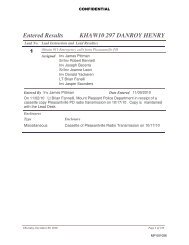Slavery in the Lower Hudson Valley - The Journal News
Slavery in the Lower Hudson Valley - The Journal News
Slavery in the Lower Hudson Valley - The Journal News
You also want an ePaper? Increase the reach of your titles
YUMPU automatically turns print PDFs into web optimized ePapers that Google loves.
A <strong>News</strong>paper-<strong>in</strong>-Education Supplement to <strong>The</strong> <strong>Journal</strong> <strong>News</strong> • LoHud.com<br />
<br />
Philipsburg Manor<br />
Philipsburg Manor is a liv<strong>in</strong>g-history site that tells <strong>the</strong> story of <strong>the</strong><br />
23 enslaved Africans who lived and labored at Philipsburg Manor <strong>in</strong><br />
1750. A colonial-era provision<strong>in</strong>g plantation that exported food for<br />
<strong>the</strong> sugar plantations <strong>in</strong> <strong>the</strong> West Indies, Philipsburg Manor also tells<br />
<strong>the</strong> story of <strong>the</strong> development of commerce and cultural diversity<br />
<strong>in</strong> colonial New York. Hands-on activities and tours of Philipsburg<br />
Manor’s gristmill, farm, manor house, slaves’ garden, and activity<br />
center open a w<strong>in</strong>dow <strong>in</strong>to what daily life was like <strong>in</strong> 1750 for<br />
<strong>the</strong> enslaved community. In th<strong>in</strong>k<strong>in</strong>g and talk<strong>in</strong>g about<br />
issues and events of that time, visitors to <strong>the</strong><br />
property ga<strong>in</strong> an understand<strong>in</strong>g of <strong>the</strong><br />
past and <strong>the</strong> present.<br />
Establish<strong>in</strong>g <strong>Slavery</strong><br />
In New York<br />
<strong>The</strong> history of how Philipsburg Manor developed beg<strong>in</strong>s with <strong>the</strong> settlement<br />
of <strong>the</strong> colony of New Ne<strong>the</strong>rland by <strong>the</strong> Dutch West India Company (DWIC)<br />
<strong>in</strong> 1624. <strong>The</strong> Dutch had acquired <strong>the</strong> land from Native Americans through<br />
purchase as well as through unfair practices. This colony was set up as a bus<strong>in</strong>ess,<br />
and <strong>the</strong> ma<strong>in</strong> goal was for <strong>the</strong> DWIC to profit from trad<strong>in</strong>g beaver pelts and o<strong>the</strong>r<br />
goods from America with Europe. In 1625, <strong>the</strong> Dutch, who had been <strong>in</strong>volved <strong>in</strong><br />
<strong>the</strong> slave trade s<strong>in</strong>ce <strong>the</strong> 1590s, brought <strong>the</strong> first group of eleven enslaved male<br />
Africans to New Amsterdam (Manhattan Island) <strong>in</strong> order to build and support <strong>the</strong><br />
roads, houses, and forts of <strong>the</strong> new colony.<br />
Despite efforts to draw Nor<strong>the</strong>rn Europeans to New Ne<strong>the</strong>rland, <strong>the</strong> population<br />
of <strong>the</strong> colony did not grow enough to support a trad<strong>in</strong>g post outside of <strong>the</strong><br />
Ne<strong>the</strong>rlands. As a result, <strong>the</strong> DWIC decided to br<strong>in</strong>g more enslaved Africans to<br />
New Ne<strong>the</strong>rland. Enslaved Africans labored as caulkers, blacksmiths, bricklayers<br />
and masons to make improvements to <strong>the</strong> slow-grow<strong>in</strong>g colony. By <strong>the</strong> 1640s, <strong>the</strong><br />
African population <strong>in</strong> New Ne<strong>the</strong>rland <strong>in</strong>cluded free persons of African descent.<br />
Although few <strong>in</strong> number, <strong>the</strong>se <strong>in</strong>dividuals had purchased or o<strong>the</strong>rwise ga<strong>in</strong>ed<br />
<strong>the</strong>ir freedom. Free blacks owned land, married <strong>in</strong> <strong>the</strong> Dutch Reformed Church,<br />
and passed along <strong>in</strong>heritances to <strong>the</strong>ir children.<br />
<strong>The</strong> English seized control of New Ne<strong>the</strong>rland <strong>in</strong> 1664 and divided it <strong>in</strong>to <strong>the</strong><br />
two colonies of New York and New Jersey. By 1720, 5,740 enslaved <strong>in</strong>dividuals<br />
lived <strong>in</strong> <strong>the</strong> colony of New York (16% of <strong>the</strong> total population) and about half that<br />
number lived <strong>in</strong> New Jersey. In 1750, <strong>the</strong> enslaved population of New York was<br />
11,014 (14% of <strong>the</strong> total population), nearly double <strong>the</strong> figure of 1720.<br />
Interpretation of map of New Amsterdam c. 1640






